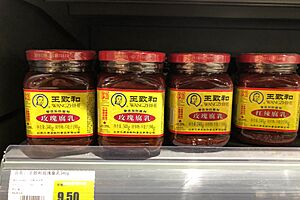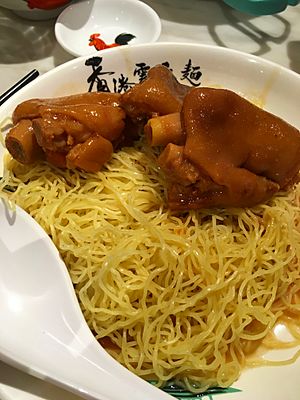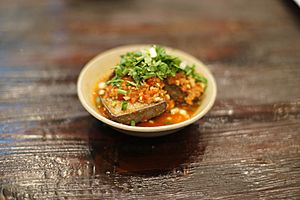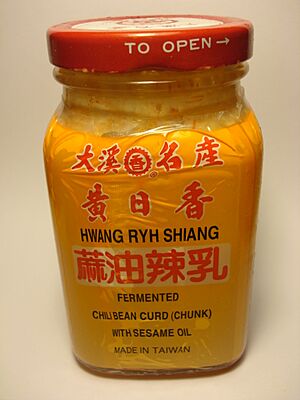Fermented bean curd facts for kids
Quick facts for kids Fermented bean curd |
|||||||||||||||||||
|---|---|---|---|---|---|---|---|---|---|---|---|---|---|---|---|---|---|---|---|
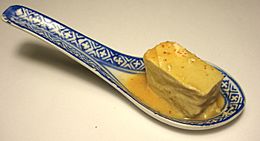
Fermented tofu
|
|||||||||||||||||||
| Chinese name | |||||||||||||||||||
| Chinese | 豆腐乳 | ||||||||||||||||||
| Literal meaning | bean curd cream | ||||||||||||||||||
|
|||||||||||||||||||
| Alternative Chinese name | |||||||||||||||||||
| Chinese | 腐乳 | ||||||||||||||||||
|
|||||||||||||||||||
| Second alternative Chinese name | |||||||||||||||||||
| Chinese | 乳腐 | ||||||||||||||||||
|
|||||||||||||||||||
| Third alternative Chinese name | |||||||||||||||||||
| Chinese | 豆乳 | ||||||||||||||||||
|
|||||||||||||||||||
| Fourth alternative Chinese name | |||||||||||||||||||
| Chinese | 豆鹹 | ||||||||||||||||||
|
|||||||||||||||||||
| Vietnamese name | |||||||||||||||||||
| Vietnamese | chao | ||||||||||||||||||
Fermented tofu is a special food from China. People also call it fermented bean curd, tofu cheese, or soy cheese. It is made from tofu that has been preserved. This means it is treated so it can last a long time. You can find it in many East Asian dishes. It is usually made with soybeans, salt, rice wine, and sesame oil or vinegar. In some places, it is sold fresh. In other countries, you might find it in jars. These jars have small blocks of tofu soaking in a salty liquid with different flavors.
Contents
History of Fermented Tofu
Fermented tofu has a long history! A book from 1596, called Compendium of Materia Medica, says that tofu was first made by Prince Liu An. He lived in China during the Han dynasty, a very long time ago (around 179 to 122 BC). People started making fermented tofu during the Han Dynasty too.
Different Names for Fermented Tofu
In Mandarin Chinese, fermented tofu is often called dòufǔrǔ, dòurǔ, or fǔrǔ. In some parts of southwest China, it is known as lǔfǔ. In English, people sometimes call it "soy cheese" because of its texture.
Nutritional Value of Fermented Tofu
Fermented tofu is good for you! It contains many helpful things like organic acids and special flavors. It also has a lot of protein, amino acids, fat, and carbohydrates. You can find vitamins like thiamine and riboflavin in it too. It also has calcium and phosphorus, which are good for your bones. The best part is that it has no cholesterol. About 12% to 22% of fermented tofu is protein.
Scientists have studied different types of fermented tofu. For example, red fermented bean curd has more alcohols and acids than the white kind. This is because of the special red rice used in its making. These differences make them taste and look unique.
What Fermented Tofu is Like
Fermented tofu has a special feel in your mouth, a bit like some dairy products. This is because its proteins break down during drying and fermentation. Before it is fermented, tofu does not have a strong taste. But after it is fermented in its liquid, it takes on a rich flavor and smell. It tastes salty with a little sweetness. The texture is smooth and creamy, like a soft blue cheese. That is why some people call it "Chinese cheese." If you keep it in the fridge, it can last for several years. Many people believe its flavor gets even better over time.
How to Use Fermented Tofu in Cooking
Fermented tofu is often used as a condiment. This means it is added to other foods to give them flavor. You can mix it into sauces for hot pot or eat it for breakfast. Many people enjoy it with rice, porridge, or congee. Usually, you take a small piece of the tofu block and eat it with a spoonful of porridge. The liquid it comes in can also be used to add flavor to your food.
You can also add a small amount of fermented bean curd to stir-fried or braised vegetable dishes. It is especially good with leafy green vegetables like water spinach. In the Chaoshan region of China, fermented tofu is a main ingredient in a special stuffed biscuit called furu bing.
Fermented Tofu Compared to Cheese
Both tofu and cheese are made from curds. Tofu curds come from soy milk, and cheese curds come from dairy milk.
- Tofu curds are made by adding things like calcium sulfate to soy milk. This makes the proteins stick together.
- Cheese curds are made by adding rennet to dairy milk. This helps the milk proteins change.
After the curds are formed, they are pressed to make tofu. Fresh tofu does not have much flavor and spoils quickly, like fresh, unaged cheese. But fermented tofu, like aged cheese, is ripened with tiny living things called microorganisms. This process gives it a lot of flavor and helps it last a long time.
Types of Fermented Tofu
White preserved bean curd is the most common type. Its flavor and smell can change depending on the spices and seasonings used. A common mix is 10% rice wine and 12% salt. If it has no alcohol, it is called "small cheese cubes." If it has double the alcohol, it is called "drunken cheese." You can also find this type with chili or sesame oil. Other seasonings might include anise, cinnamon, lemon juice, or dried shrimp. Sometimes, you can buy the tofu dried without the liquid, in paper boxes.
Red fermented bean curd (hóngfǔrǔ or nánrǔ) gets its deep red color from red yeast rice. This rice is grown with a special mold called Monascus purpureus. This type has a thicker flavor and smell. It can also contain chili. A popular version of this red tofu looks like ketchup and is flavored with rose wine, caramel, and sugar.
Stinky fermented bean curd is fermented for over six months. It is popular for its strong, creamy flavor. However, it has a very strong smell, so it is an acquired taste. Stinky sufu looks like regular white sufu cubes and has a similar smooth, soft texture. In Taiwan, there is a green version made with sake lees, crushed leaves, and a green mold. It is fermented for 12 hours and sold on the streets.
Chiang fermented bean curd (Chiang-doufu) is made by soaking tofu cubes in Chinese-style miso or soy sauce for several days. It is usually reddish-brown and salty. It can be dried and fermented more, or mixed with sake lees. In Japan, miso is used to make a similar product.
How Fermented Tofu is Made
To make fermented bean curd, first, cubes of dried tofu are left to air-dry. They are often placed under hay. During this time, tiny bacteria and fungal spores from the air slowly ferment the tofu. For fermented tofu sold in stores, dry, firm tofu is used. It is given special fungal spores, such as Actinomucor elegans or Mucor sufu. This freshly fermented tofu is called 'mold tofu'.
Next, the dry, fermented tofu is soaked in a salty liquid called brine. This brine often has Chinese rice wine, vinegar, chili peppers, or sesame oil added to it. Sometimes, a paste made of rice and soybeans is used. For red fermented bean curd, red yeast rice is added to the brine to give it its color. Fermented bean curd is usually sold in small glass jars.
See also
 In Spanish: Tofu encurtido para niños
In Spanish: Tofu encurtido para niños
Images for kids


